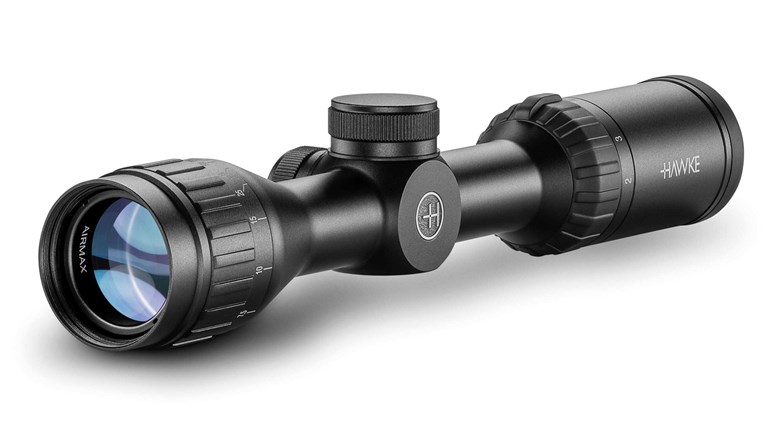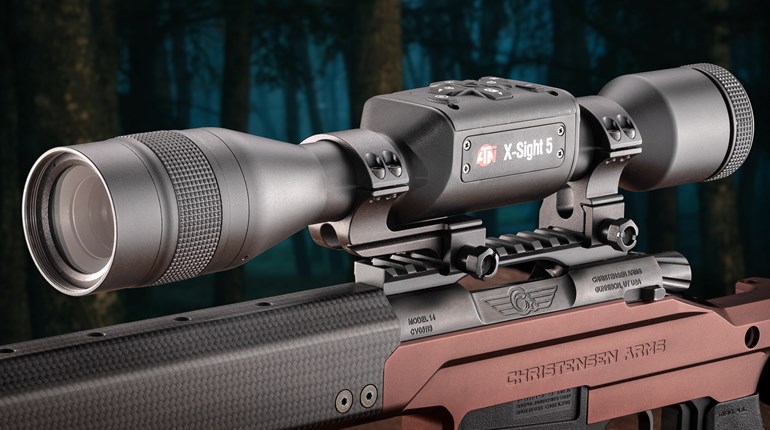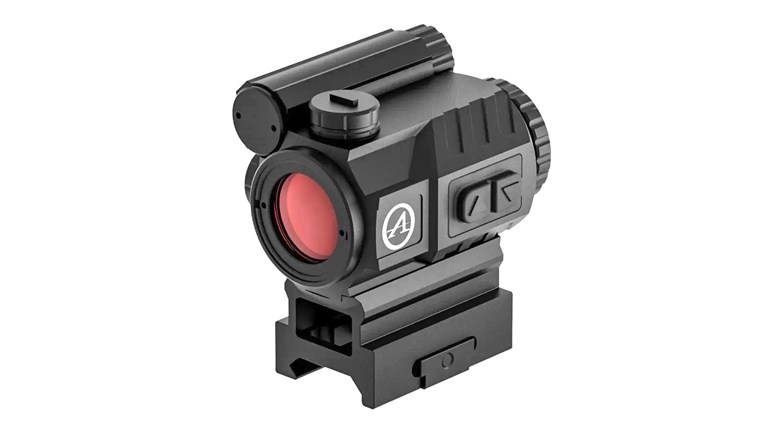
Dawn breaks in Afghanistan. It's cold, raining, the wind is blowing and you're in mud up to your chin. Your mission: take out a sentry, and the range to target is 1,213 yards. But there's a problem. Unexpectedly, and only 397 yards in front of you, a Taliban fighter is sitting on a rock holding an AK like a newborn baby. You'll have to shoot the close insurgent first and 3.1 seconds later the sound from that shot will reach your intended target. You're going have to be fast. Good thing the B.E.A.S.T. is with you.

You dial in a 4.5-MOA elevation correction for the close shot. You need to compensate for wind, but you know you cannot make both windage and elevation adjustments and get the second, longer shot off in less than the 3 seconds it will take the report to travel 1,200 yards. So, you dial in a wind correction of 7.5 MOA for the long shot. You'll use the MOA reticle to hold 5.5 MOA with the wind for the closer target.
You breathe in, let it out and squeeze. The 250-grain Sierra MatchKing smacks the AK-wielding terrorist, and you swiftly spin the elevation knob 56 clicks—about half a rotation—counterclockwise for the necessary 28 MOA of correction. Knowing you would need an additional .25 MOA of correction at 1,200 yards, the M2 lever has already been flipped. You center the reticle on the primary target and squeeze again.
Time between shots: 2.3 seconds. Eight tenths of a second after you pulled the trigger for the second time, the sentry hears a muffled pop from your first suppressed shot. It takes him a half second to react. He reaches for his binocular. Your first bullet left your barrel 3.6 seconds ago and .4 second later, your second bullet arrives, center mass. Task one is complete, and your team is ready for the breach.

I've done some distance shooting and have even been trained by some of the best instructors, but I'm no expert on long-range shooting or the optics required for that task. To give the B.E.A.S.T. a real-world test, I enlisted the expertise of Mike Moore, a long-range shooting instructor at Gunsite. I also needed a serious rifle, so I asked ArmaLite for an AR 30A1 rifle chambered in .338 Lapua Mag.
Moore guided the testing. I listened, learned and pulled the trigger. After zeroing, we ran the scope through a box drill to test the adjustments, and then we whacked steel targets and disabled vehicles out to almost the next ZIP code, spinning the adjustment turrets like we were trying to dial in a classic rock station.
Moore summed up the tests saying, "The clarity of the optics was fantastic, and the box test verified the adjustments were repeatable and well within acceptable spec. As with any Nightforce scope, the B.E.A.S.T. appears to be very hardy and tough, and I really like the locking turrets, the zero stop and the way the illuminated reticle is adjusted."
The B.E.A.S.T. is a $3,500 precision optical instrument. Performance cannot simply be summed up by saying, "it worked just fine" or by relaying some fact-based, fictional account. Neither educates you on the distinctiveness and mission-specific characteristics of this optical innovation.
For starters, the B.E.A.S.T. is a 16-inch-long, 5-25X magnifying optic with a 56 mm objective lens. It is built on a 34 mm tube of high-grade aircraft aluminum. This scope is tough—it can withstand repeated impacts of 1,250 Gs, submersion in 100 feet of water for 24 hours and temperature swings of 240 degrees. Just as important as ruggedness, 6 inches of mounting space means you can position the B.E.A.S.T. to suit your needs on any weapon system. Proportionally speaking, it is an industry best for this size riflescope.
Nightforce uses the best glass money can buy for the B.E.A.S.T. By using optically indexed lenses—which sport proprietary coatings that meet military abrasion standards, maximize light transmission and enhance color rendition—the image you see through this scope is bright, crisp and clear from edge to edge. To make sure the expensive glass is protected, the lenses are bedded with a special material to eliminate glass-to-metal contact. They are then sealed with a rubber O-ring on both sides.

Understanding the B.E.A.S.T. would likely be mounted on powerful, high-performance rifles, an optimal eye relief of 3.44 inches was established to keep the ocular housing from whacking you in the brow when the scope rides a hard kicker. Eye relief only varies by plus or minus .1 inch in either direction through the magnification range.
The heart of the B.E.A.S.T. is the adjustment system and its interface with the five available reticle options: the illuminated Nightforce MOAR, MIL-R, MD 2.0 and the Horus Vision H59 and TReMoR2. These reticles are all positioned in the first focal plane, which means regardless of the reticle you choose, it can be used for correction and range estimation at any magnification setting. Equally important, if you choose an MOA- or mil-based reticle, you get MOA or mil adjustments.
Speaking of adjustments, take a breath, relax and clear your mind. Unlike most long-range riflescopes, the B.E.A.S.T. uses either .5-MOA or .2-mil clicks. The primary reason for this is to allow quicker adjustments—clicks—when shooting at long range. For example, one complete turn of the i4F (intelligent Four Function) elevation-adjustment knob will give you 60 MOA or 20 mil of adjustment, or more than 600 inches at 1,000 yards. In other words, if you need to make a quick correction from say 300 yards to 1,100 yards, you'll only spin the knob about a half rotation.
You're probably thinking .5-MOA or .2-mil adjustments are not fine enough for long-range shooting. That point can certainly be argued, but Nightforce has an answer. You see, the B.E.A.S.T. is fitted with what Nightforce calls an M2 lever. This lever—located at the base of the elevation turret—adds .25 MOA of elevation to whatever setting you have already dialed in. Let's say your DOPE (Data Of Previous Engagement) calls for a 22.75 MOA correction. You would dial the knob to 22.5 and flip the M2 lever to add another .25 MOA. That .25 MOA remains in the system until you flip the lever back. For mil-based adjustments, the M2 lever adds .1 mil of correction.
Windage adjustment is also in either .5-MOA or .2-mil increments with a total of 15 MOA—or 6 mils—of adjustment left or right of zero. However, don't confuse this with total windage-adjustment range, which is 80 MOA or 23.27 mil. After zeroing, the windage-adjustment dial will operate for one full turn and your zero setting is in the center of this rotation. You cannot over-rotate your windage correction past your zero setting. In addition, the windage knob has a lockout—a small button on the outer edge of the dial—that must be depressed to adjust from zero or to pass your zero with a left or right rotation.
If I wanted the best long-range riflescope money could buy, I'd put a B.E.A.S.T. on my rifle.
Specifications
Manufacturer: Nightforce; (208) 476-9814
Magnification: 5-25X
Objective Lens Diameter: 56 mm
Tube Diameter: 34 mm
Ocular Bell Diameter: 46 mm
Field of View at 100 Yards: 18.7 feet at 5X; 4.9 feet at 25X
Eye Relief: 3.54 inches at 5X; 3.35 inches at 25X
Adjustment Range: 120 MOA (34.9 mil) elevation; 80 MOA (23.27 mil) windage
Click Value: .5 MOA or .2 mil with a .25-MOA or .1-mil increment lever
Available Reticles: MIL-R(F1), MOAR (F1), MD 2.0, Horus Vision TReMoR 2, Horus Vision H59
Length: 15.37 inches
Weight: 39 ounces
MSRP: $3,400 ($3,900 with Horus Vision reticles)






































